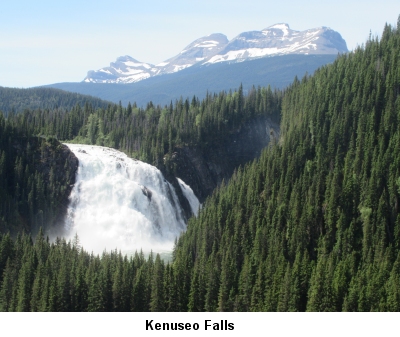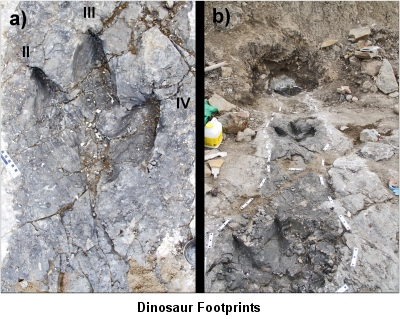Tumbler Ridge Geopark.
by John Neville
This article first appeared in the spring edition of BC Nature 2017
The world we know and love has left us many clues to its 4.6 billion year history.
For example the huge land mass called Pangea eventually divided into Gondwana and Laurencia.
Laurencia contained what today we know as North America, Europe and Asia. The earth’s crust continues to adjust itself to this day.
The crust is divided into plates and these tectonic plates are continuously rubbing against each other.
Earth quakes and volcanoes are constant reminders of the slowly changing world we live in.
 In 2014, UNESCO recognized Tumbler Ridge as a Geopark, only the second in North America.
A geopark is a concentrated area where a large number of clues to the earth’s past are found.
Our awareness of this region began to increase during the 1980's when a coal mine, roads and a railway were established.
It's located on the eastern slopes of the Northern Rockies, about three or four hours drive northeast of Prince George.
In the year 2000, two boys found the first fossilized Dinosaur tracks. Since then a real trove of fossils have come to light!
This links the area with the rest of the Peace River drainage and eastwards into Alberta and beyond.
This is a place well worth visiting, and is being considered by both BC Nature and Nature Vancouver for a possible camp.
In 2014, UNESCO recognized Tumbler Ridge as a Geopark, only the second in North America.
A geopark is a concentrated area where a large number of clues to the earth’s past are found.
Our awareness of this region began to increase during the 1980's when a coal mine, roads and a railway were established.
It's located on the eastern slopes of the Northern Rockies, about three or four hours drive northeast of Prince George.
In the year 2000, two boys found the first fossilized Dinosaur tracks. Since then a real trove of fossils have come to light!
This links the area with the rest of the Peace River drainage and eastwards into Alberta and beyond.
This is a place well worth visiting, and is being considered by both BC Nature and Nature Vancouver for a possible camp.
The rock formations date from the Pre-Cambrian to the Cretaceous, and more recently to the Pleistocine era. The mountain topography is more gentle than the cliffs of the Frontal Range further south. This allows for great hiking and spectacular scenery, such as Kenuseo Falls. As the Rockies rose up, peat was deposited in swampy areas along the coastline of the inland sea. These became the metallurgical coal seams, and natural gas deposits that have led to the establishment of a local community. Tumbler Ridge has also proved ideal for wind power development. Fossils are plentiful: featuring Mississippian invertebrates, Triassic fish and marine reptiles, Cretaceous Dinosaur trackways, Dinosaur bones and plants. As the Rockies rose and folded they left the oldest seams to the west and the youngest to the east. The Cambrian rocks display invertebrate burrows. Ordovician rocks harbour corral reefs which have formed Stromatoporoids, accumulated in huge numbers and thickness. This was during the Devonian period, 419 to 359 million years ago, when the area was in equitorial latitudes. During the Mississipeaan period, 359 to 323 million years ago, the Limestone rocks show large numbers of fossil clams, worms, Crinyds, Brachiopods, Ammonoids, Bryozoans, Trilobbits, and Elastoids. Local caves have allowed an in depth exploration of some of the limestone deposits. The next era of importance for the fossil record is the Triassic period, 252 to 201 million years ago, in the marine rocks. These animals had survived the Permian extinctions and the super continent Pangaea was beginning to break up. The fragment known as Laurencia became: Asia, Europe and North America. The collision of some of these huge land masses are thought to have caused the Permian exstinction, just before the Triassic era. The first fossil fish invertebrates were found at Fossil Fish Lake in 1947, near Wapiti Lake Provincial Park and included over 20 genera of fishes, and over a dozen genera of marine reptiles. The fish include sharks, Lobe finned fishes like Coelacanths and Ray finned fishes. Coelacanths were thought to have become extingct 70 million years ago, but a few have been caught off the east coast of Africa since 1937. The Coelacanths and Lung Fish are thought to have been the major link between marine animals and those invading the land such as amphibians. The marine reptiles are also interesting and include: Ichthyosaurs, Myxosaurs and Thalattosaurs. About 20 years ago a huge,15 meter long Ichthyosaur was removed from Pink Mountain to the Royal Tyrrel Museum in Alberta. These rocks also harbour Ammonites,and Crustaceans. As more land forms were joined to the BC coastline, the Rockies were forced upwards from the ancient inland sea. Today some of the fossils are found on top of mountains because of the huge geological changes. To the east of the new mountains swampy land was created. This eventually led to the creation of metallurgical coal, which is present in several places along the Canadian Rockies. Because the Tumbler Ridge Geopark was sometimes underwater, and sometimes a land mass a variety of fossils are present. There are: Ankylosaurs, Therapod tracks, large Ornithopod trackways, the most northerly Sauropod tracks currently known Avian, Crocodillian, Turtle and invertebrate tracks.  The first Ankylosaur bones in BC were found at Tumbler Ridge in 2001.
In 2002 the first accumulation of Dinosaur bones were found in the Geopark.
The first Ankylosaur bones in BC were found at Tumbler Ridge in 2001.
In 2002 the first accumulation of Dinosaur bones were found in the Geopark.
In 2013 excavations revealed the presence of multiple dinosaur bones. A Tyranosorous Rex tooth and a Cretaceous Angiosperms (flowering plants) leaf were special discoveries. Other interesting critters from the Cretaceous period are Oysters, Inoceramids and Starfish impressions. The rocks in the park are marked by ice age action. There were two great ice age sheets: the Laurentide which spread from the polar region and the Cordilleran which spread eastwards from the Rockies. Much of the present topography of this region is due to the glaciers and their subsequent melting. There are Morraines, terraces, remnants of old lakes shores, and glacial till which makes digging in the Tumbler Ridge gardens difficult! In the Peace River Palaeontology Research Center is a 22000 year old Mammoth tusk, found in nearby Taylor. In 1986 a huge Bison skull was found in a quarry dating back 12000years, immediately after the ice age. Since the end of the coal mining boom Tumbler Ridge has been struggling to survive as a community. After the discovery of Dinosaur tracks in 2000, it is emerging as a very special place in British Columbia for fossils. Just like Drumheller's Tyrrel Museum, and the new museum at Wembley Alberta, Tumbler Ridge BC is becoming a destination for knowledge hungry tourists. The world began about 4.6 billion years ago. Here are the main chapters in the earths long geological story, as shown at Tumbler Ridge. 4.5 billion years ago: Precambrian Era. Paleozoic Era. 545 million years ago, Cambrian Period. Invertebrate burrow Fossils. 490 million years ago: OrdovicianPeriod. Nautiloids. 440 million years ago: Silurian Period. 420 million years ago: Devonian Period. Stromatoporoids forming Limestone and Trilobites. 355 million years ago: Carboniferous Period. 359 to 323 million years ago: Mississippian Period. Laurentia was forming, clams, worms, Brachiopodsea Crinoids, Ammonoids, Brachiopods, Trilobits Blastoids were found. 300 million years: Permian Period. This included the massive Permian extinctions. The Mesozoic Era. 252 million years ago: Triassic Period. Fish and marine reptile fossiles: 20 generae of fish and more than a dozen reptiles. These include: Shark, Coelacanths Ray-finned fish, the reptiles include Ichthyosaurs, and Thalattosaurs. The rocks also harbour: Ammonites Belemnites, and Crustaceans. 200 million years ago: Jurassic Period. 145 million years ago: Cretaceous Period. Dinosaur trackways, (including Ankylosaurs, Therapods, and Tyranasaur), Dinosaur bones, Crocodilian and Turtle tracks, and bird tracks. Invertibrates such as Oysters and Starfish impressions. In the late Crystassious period abundant Redwood furns and other plants were replaced by flowering plants known as Angiosperms. Tertiary Period. 65 million years ago: Paleocene Epoch. 55 million years ago: Eocene Epoch. 34 million years ago: Oligocene Epoch. 24 million years ago: Miocene Epoch. 5 million years ago: Pliocene epoch. Quaternary Period. 1.6 million years ago: Pleistocene Epoch. Discovery of a Mammoth tusk and the skull of a Bison. 10 thousand years ago to the present. Holocene Epoch. I hope these times and dates give you a sense of the importance of Tumbler Ridge's fossil record. To see some of this historic information, a visit to the Peace River Palaeontology Research Center is well worthwhile. For further information go to www.prprc.com My thanks to Dr Lisa Buckley for all her technical support. John Neville. |